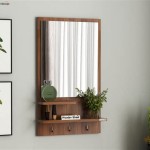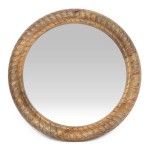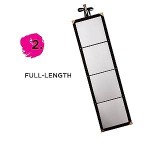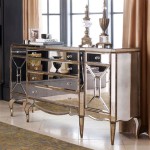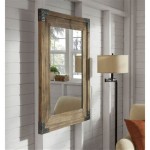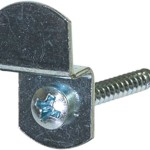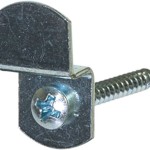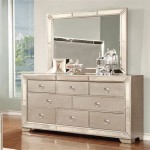How to Hang a Heavy Frameless Mirror Securely
Hanging a heavy frameless mirror requires careful planning and execution to ensure both safety and aesthetics. The absence of a frame removes a traditional mounting point, necessitating alternative methods that provide ample support and distribute the weight evenly.
Key Considerations Before Starting
Several factors influence the appropriate hanging method. Evaluating these beforehand ensures a successful installation.
1. Mirror Weight: Heavier mirrors demand stronger mounting hardware and potentially more mounting points.
2. Wall Type: Different wall materials (drywall, concrete, brick) require specific fasteners and anchors.
3. Mirror Size and Shape: Larger or irregularly shaped mirrors might necessitate specialized mounting systems.
4. Desired Placement: The location of the mirror influences the visibility of the mounting hardware and the necessary accessibility for installation.
Essential Tools and Materials
Gathering the correct tools and materials beforehand streamlines the hanging process.
Required Items:
1. Heavy-Duty Mirror Adhesive: Opt for an adhesive specifically designed for mirrors and rated for the appropriate weight.
2. J-Channels or Z-Clips: These provide a secure grip on the mirror's edges without visible hardware from the front.
3. Level: Ensuring the mirror hangs perfectly straight is crucial, particularly for frameless designs where any tilt is immediately apparent.
4. Measuring Tape: Precise measurements are essential for accurate placement and alignment of mounting hardware.
5. Drill with Appropriate Bits: The necessary drill bit depends on the wall type and chosen anchors.
6. Wall Anchors: Choose anchors appropriate for the wall type and the mirror's weight. Examples include toggle bolts for drywall and concrete anchors for masonry.
7. Screws: Ensure the screws are compatible with the chosen anchors and are long enough to provide secure fastening.
8. Pencil: Marking the desired placement and drilling points ensures accurate installation.
9. Safety Glasses and Gloves: Protecting eyes and hands is vital when working with drills and heavy objects.
Method 1: Using J-Channels or Z-Clips
J-channels and Z-clips offer a discreet and robust solution, particularly suitable for larger, heavier mirrors.
Installation Steps:
1. Measure and Mark: Determine the desired mirror placement and mark the top and bottom edges on the wall using a level and pencil.
2. Install Channels/Clips: Attach the J-channels or Z-clips to the wall along the marked lines, ensuring they are level and securely fastened with appropriate anchors and screws.
3. Apply Adhesive (Optional): For added security, especially with extremely heavy mirrors, apply mirror adhesive to the back of the mirror following the manufacturer’s instructions.
4. Place the Mirror: Carefully slide the mirror into the channels or clips, ensuring it is fully seated and level.
Method 2: Using Mirror Adhesive
Mirror adhesive provides a strong bond and is often suitable for smaller to medium-sized frameless mirrors.
Installation Steps:
1. Prepare the Wall: Ensure the wall surface is clean, dry, and free of dust or debris.
2. Apply Adhesive: Following the manufacturer's instructions, apply the adhesive to the back of the mirror in a pattern appropriate for its size and weight. Avoid applying adhesive too close to the edges.
3. Position the Mirror: Carefully position the mirror against the wall, using a level to ensure it is straight. Apply firm, even pressure for the duration recommended by the adhesive manufacturer.
4. Support the Mirror: For heavier mirrors, use temporary supports (e.g., painter's tape or wooden blocks) to hold the mirror in place while the adhesive cures fully.
Important Safety Precautions
Safety should always be the top priority when hanging heavy objects.
Safety Guidelines:
1. Use Appropriate Weight Ratings: Ensure all chosen materials, including adhesive, anchors, and clips, are rated for the weight of the mirror.
2. Seek Assistance: Enlist help when handling heavy mirrors to prevent accidents and ensure proper placement.
3. Follow Manufacturer Instructions: Adhere to the specific instructions provided by the manufacturers of the adhesive, mounting hardware, and the mirror itself.
4. Consider Professional Installation: For exceptionally large or heavy mirrors, or if you are unsure about any aspect of the process, consulting a professional installer is recommended.
Choosing the Right Mounting Method
Selecting the appropriate method depends on the specific characteristics of the mirror and the wall.
Method Selection:
1. Lightweight Mirrors: Mirror adhesive alone might suffice for smaller, lighter frameless mirrors.
2. Medium to Heavy Mirrors: J-channels, Z-clips, or a combination of adhesive and clips are recommended for increased support and security.
3. Irregularly Shaped Mirrors: Specialized mounting systems or custom solutions might be necessary depending on the mirror’s shape and weight distribution.

How To Install A Mirror Without Frame Merrypad

How To Hang A Frameless Mirror On The Wall With Pictures

How To Hang A Hanging Mirror Without Accompanying Hardware

How To Hang A Frameless Mirror June 2024 Your Guide Hanging
:strip_icc()/ScreenShot2022-04-28at1.12.19PM-e055476c70c6438585fa7c5cd531edcf.png?strip=all)
4 Easy Ways To Hang A Heavy Mirror

How To Hang A Heavy Mirror C R F T

Glass And Mirror Inc Frameless Mirrors Wall Bathroom Floor

How To Hang A Frameless Mirror On Wall E Architect

Hanging A Heavy Mirror Without Frame Tiktok Search

How To Hang A Heavy Mirror Ask This Old House

